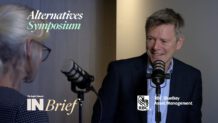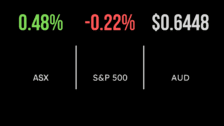Changing ETF landscape in 2020
The ETF landscape continues to rapidly expand beyond the replication of major stock market indices such as the S&P/ASX 200 and S&P 500. Today’s investor can choose ETFs across different sectors, based on certain themes or even offering alternative weighting schemes, like yield or value, captured by the phrase smart beta.
The value of the Australian ETF market is currently A$60 billion, only a small portion of the overarching A$3.7 trillion assets of the managed funds industry and a fraction of the global ETF market valued at US$5 trillion. The vastly larger US and European ETF markets offer some indication of the direction the Australian industry may take.
In 2020, ETF Securities expects a number of trends to influence the ETF landscape, including economic drivers, changing investor dynamics and newer investment styles courtesy of improving technology.
Economic drivers for the ETF landscape
Investments generally are being influenced by three key economic themes: the low interest rate environment globally, continuing challenges in the Australian economy and ongoing growth in Asia.
Global low interest rate environment. After a period of tighter monetary policy between 2016-2018, the U.S. Federal Reserve switched course and decreased rates in mid-2019. This tied in with a year of increasingly accommodative monetary policy globally. The European Central Bank (ECB) announced it would resume quantitative easing and decreased its already negative bank deposit rate to -0.5 per cent, while domestically, the Reserve Bank of Australia decreased rates three times.
This environment is likely to continue into 2020 as the global economy continues to manage sluggish growth and inflation, as well as provide a buffer for potential risks which may arise during the post-Brexit adjustment period for the UK and Europe, the escalation in activity with Iran, the typical market volatility associated with a US Presidential Election year or any changes in the current ‘cease-fire’ in the US-China trade war.
Lower interest rates continue to place pressure on traditional sources of yield like fixed income. Australian investors will need to look beyond domestic holdings to access yield in fixed income. Given this scenario, investors may be more likely to look at using riskier asset classes like equities, as well as ‘safe haven’ assets like gold.
What this means for ETFs. Commodities ETFs, in particular gold and silver, should continue to benefit from this environment due to a low opportunity cost. Gold has both consumption and investment appeal so has low correlation to equity markets and other assets.
This means it tends to perform in a range of markets and offer stability when share markets are volatile.
Investors may look towards ETFs targeting dividends as an alternative source of yield.
Investors still looking at fixed income, either for diversification or as a low risk asset, may look at the US as it holds higher yield compared to Australian and European counterparts.
Challenges in the Australian economy. On the whole, performance has been positive for the Australian market across 2019 but has lagged peers and this is likely to continue in 2020.
The Australian economy has been challenged over the past few years by a slowdown in the resources sector, falls in the residential property market, along with stagnant wage growth and employment numbers. Corresponding to this, the Australian dollar is low relative to recent history – $US0.70 as at 31 December 2019.
While these issues have affected investment, there have also been domestic themes taking a dominant role. For example, the ramifications of the Royal Commission into Misconduct in the Banking, Superannuation and Financial Services Industry both in terms of regulation and penalties, along with damaged consumer trust, continues to influence the stock prices of many financial companies. The extent of the devastating fire season in Australia is as yet unknown but will be felt heavily in the financial sector, especially in the insurance industry.
Investors may consider a few options from this scenario. One aspect is sourcing opportunities overseas or focusing on more niche areas both within and external to Australia which are less likely to be influenced by the current dynamics. A second is considering the impact of currency, given the low Australian dollar.
What this means for ETFs. Investors may look to currency-based ETFs offering exposures outside Australia, particularly to the US dollar which continues to be stronger than many developed nation currencies.
ETFs in themes or markets to offset the financials exposure in Australia, for example, in technology and medical sectors or in emerging markets.
Growth in the Asian region. The growth of the middle-class across Asia has been a market theme for more than a decade, despite concerns over Chinese slowdown. Investors are becoming increasingly aware of the opportunities for countries outside of China such as India, Malaysia or South Korea.
India, for example, is expected to see the percentage of households in poverty drop from 15 per cent to 5 per cent by 2030 representing a huge opportunity in terms of consumption.
Even as the Chinese economy slows and the trade war with the US continues to drive uncertainty, it still represents opportunity for growth.
A number of companies are starting to emerge as global power players from the Asian region, with massive and growing client bases and the ability to leverage to other regions. Chinese based company Alibaba and Indian multinational Infosys Ltd are some examples.
External to Asia, a number of companies and sectors have spent the past decade developing strategies and positioning to take advantage of this growth. Luxury consumer discretionary brands like LVMH are already reaping the benefits, while healthcare and vitamin companies like Blackmores are discovering consumers who are focused on their health needs and have the finances to pay for it.
What this means for ETFs. ETFs specific to the Asian region including those focused on individual countries like India, along with ETFs covering themes that benefit from Asian growth will continue to be of interest.
ETFs targeting sectors like healthcare or even focused on medical advancements such as ETFS S&P Biotech ETF (ASX Code: CURE) are also positioned to take advantage of a growing customer base in Asia who seeks out and can afford the latest and best. This is also supported by the growing medical tourism industry in Asia, targeting those tourists wanting to take advantage of the lower cost bases for treatment.
Changing investor dynamics and ETFs
Investor needs and demands have been responsible for change across much of the investment industry, with transparency and costs, along with ethical and social concerns, becoming a key focus.
Demand for greater transparency and cost-effective investments. Influenced by the Global Financial Crisis and the more recent Royal Commission, investors are taking a greater interest in where and what their investments are. Transparency over investments and the investment approach is becoming important. Investors are also becoming more conscious of fees and aware that costs can erode returns.
This is having a flow-on effect to investment managers and financial advisers, requiring them to not only justify their own fees but be more conscious of fee budgets within portfolios.
What this means for ETFs. The trend towards transparency and cost focus is supportive of ETFs, which typically offer these characteristics and can be easily traded should they no longer meet an investors’ strategy and needs.
A tighter focus on fee budgets in managed funds and portfolios make ETFs an attractive option to access specific themes, offer broad exposure or tilt a portfolio.
Ethical and social concerns. Linking to a greater interest in transparency, investors are also starting to consider incorporating their ethical and social values within their investments. Many companies are starting to be vocal about their Environmental, Social and Governance (ESG) policies. To some extent, this is a basic expectation for investors – even the greatest polluters have an ESG policy. In recent times,
investors have started to look at incorporating specific themes, like climate change or socially responsibility, within their investments. This is still emerging in the Australian market and is more developed in the US market, which even offers impact investment style ETFs.
What this means for ETFs. Growth in ESG and ethical ETFs will continue in response to investor demand and innovation in a quickly developing segment.
This may also support more bespoke ETF strategies, for example, some dealer groups have started to consider broad based indices with an ethical overlay for core exposures in their clients’ portfolios.
Kris Walesby is the chief executive of ETF Securities
The ETF landscape continues to rapidly expand beyond the replication of major stock market indices such as the S&P/ASX 200 and S&P 500. Today’s investor can choose ETFs across different sectors, based on certain themes or even offering alternative weighting schemes, like yield or value, captured by the phrase smart beta.










